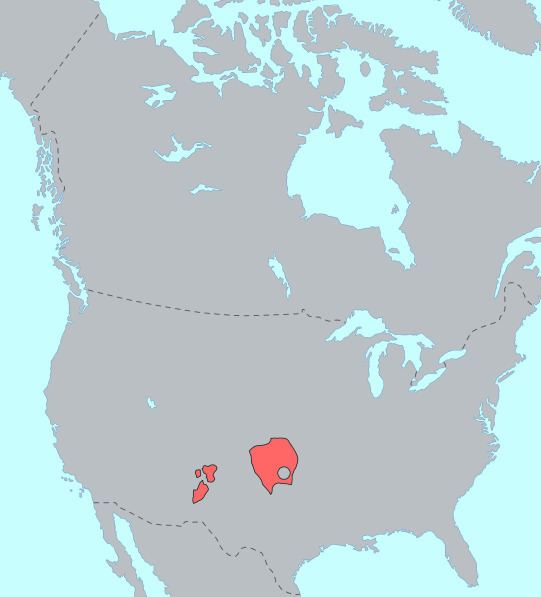Linguasphere 64-C | Subdivisions TiwaTewaTowaKiowa Glottolog kiow1265 | |
 | ||
Linguistic classification One of the world's primary language families | ||
Tanoan /təˈnoʊ.ən/, also Kiowa–Tanoan or Tanoan–Kiowa, is a family of languages spoken by indigenous peoples in present-day New Mexico, Kansas, Oklahoma, and Texas.
Contents
Most of the languages – Tiwa (Taos, Picuris, Southern Tiwa), Tewa, and Towa – are spoken in the Native American Pueblos of New Mexico (with one outlier in Arizona). These were the first languages collectively given the name of Tanoan. Kiowa, which is a related language, is now spoken mostly in southwestern Oklahoma. The Kiowa had historically occupied areas of Texas and Oklahoma.
Languages
The Tanoan language family has seven languages in four branches:
Kiowa–Towa might form an intermediate branch, as might Tiwa–Tewa.
Name
Tanoan has long been recognized as a major family of Pueblo languages, consisting of Tiwa, Tewa, and Towa. The inclusion of Kiowa into the family was at first controversial among linguists. The once-nomadic Kiowa people of the Plains are culturally quite distinct from the Tiwa, Tewa, and Towa pueblos, and people in other language families have typically shared more culture. Linguists now accept that a Tanoan family without Kiowa would be paraphyletic, as any ancestor of the pueblo languages would be ancestral to Kiowa as well. Kiowa may be closer to Towa than Towa is to Tiwa–Tewa. Technically Tanoan and Kiowa–Tanoan are considered synonyms among linguists. Because of the cultural use of the name Tanoan as signifying several peoples who share a culture, the more explicit term Kiowa–Tanoan is still commonly used for the language family.
The prehistory of the Kiowa people is little known. As a result, the history is obscure about the separation of the members of this language family into two groups ('Puebloan' and 'Plains') with radically distinct lifestyles. There is apparently no oral tradition of any ancient connection between the peoples. Scholars have not determined when the peoples were connected so that the common linguistic elements could have developed. The earliest traditions and historical notices of the Kiowa record them as migrating to the north and west, to the territory now associated with the tribal nation. Today this area is within the modern states of Texas and Oklahoma), which they occupied from the late 18th century.
Genealogical relations
The Tanoan family has been connected to the Uto-Aztecan family in a hypothetical Aztec–Tanoan proposal. Although it is undemonstrated, many linguists find this hypothesis to be promising.
Historical phonology
The chart below contains the reconstructed consonants of the Tanoan proto-language as reconstructed by Hale (1967) based on consonant correspondences in stem-initial position.
The evidence for *ɡ comes from prefixes; *ɡ has not been found in stem-initial position and thus is in parentheses above. Hale reconstructs the nasalization feature for nasal vowels. Vowel quality and prosodic features like vowel length, tone, and stress have not yet been reconstructed for the Tanoan family. Hale (1967) gives certain sets of vowel quality correspondences.
The following table illustrates the reconstructed initial consonants in Proto-Tanoan and its reflexes in the daughter languages.
As can be seen in the above table, a number of phonological mergers have occurred in the different languages. Cognate sets supporting the above are listed below:
